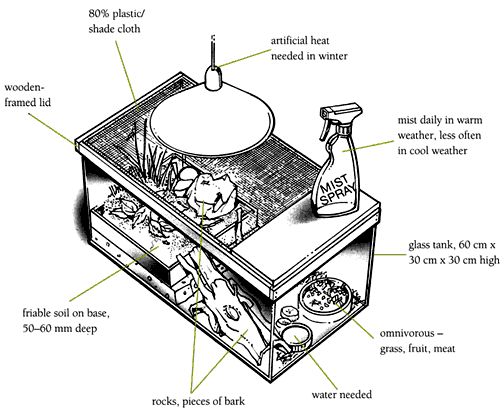You are here:
- Home »
- Teaching science »
- Caring for animals in the classroom »
- Field crickets
Field crickets
Housing
The tank
- Crickets need a glass tank 60 centimetres × 30 centimetres × 30 centimetres high with a wooden-framed lid, 80 percent of which is covered with plastic or steel insect mesh or shade cloth for ventilation.
- On the base, provide friable soil 50–60 millimetres deep, mounded to assist drainage and with leaf litter on top. This can be set up in seed trays on pieces of paving stone or bricks to provide better drainage. Ensure that the trays fit hard against the walls of the tank so that the crickets don't get underneath.
- Provide a few rocks so that the crickets can climb off the soil and some places for them to hide. Pieces of bark in layers make ideal hiding places. These should be about 20 centimetres × 15 centimetres.
Environment
- Field crickets need a warm environment. They can be kept at 20–30°C with an average temperature of 26°C. You can achieve this easily in the summer, but you will need artificial heat if the insects are to be kept during the winter. Position a 60- to 100-watt light bulb above the cage to provide the desired temperature. Test the position of the bulb before introducing it to the insects.
- Crickets need a humidity level of 40 to 60 percent. You can maintain this by misting the enclosure once a day in warm dry weather and once every four days in cool damp weather.
- More frequent misting is likely to be needed if artificial heat is used, but take care to ensure that the humidity level does not rise above 60 percent.
- Ventilation is very important. The cage should be in a well-ventilated part of the classroom, preferably away from the windows because the sun can raise the temperature to intolerable levels.
Tank diagram
- temperature range 20–30°C
- ventilation is important.

Field crickets tank: main features
Tank diagram explanation
A rectangular glass tank 60cm x 30cm x 60cm high is shown. It has a wooden framed lid and eighty percent of the lid is shade cloth or plastic – ventilation is important
There is a light above the tank to show artificial heat is needed in winter.
A mist spray bottle on the tank shows the tank needs a daily mist in warm weather and less in cooler weather.
Half the inside of the tank is a raised box with friable soil about 50–60mm deep on the base.
In the box are rocks and twigs and a piece of wood provides a bridge from the cage floor to the box. There is a small circular water lid for water on the ground and a larger one for food. Crickets are omnivorous so grass, fruit, and meat need to be provided.
Temperature range for crickets is 20–30°C.
How to care for field crickets
Feeding
- The field cricket is an omnivore. Its staple diet in captivity should include grass, fruit, such as apples, bananas, and stone fruit in 20-millimetre-sized pieces, and a selection of animal protein items, such as fish food, pet sausage, or cat biscuits soaked in water in an upturned lid.
- You can provide grass by planting clumps in the soil and replacing it as it is eaten or as it deteriorates.
- Provide drinking water in a separate lid or place a soaked wad of cotton wool in a lid.
Breeding
- If conditions are good, the crickets may breed. After mating, the female places the eggs into the soil using her ovipositor.
- Eggs are usually laid in autumn and will develop into nymphs (junior adults) when the weather warms up in spring.
- Young crickets are very active. They will grow and mature in the presence of other individuals only if ample space, shelter, and food are provided.
Copyright
The text and illustrations for this online edition of Caring for animals: A Guide for teachers, early childhood educators, and students (published on Te Kete Ipurangi for the New Zealand Ministry of Education in 2005) is copyright © Crown 2005. All rights reserved.
Content has been adapted for the web from the printed version, originally published in 1999 by Learning Media Limited for the Ministry of Education. Although no longer available this publication may still be available in some schools.

